Surgical Periodontal Disease Treatments
Pocket Reduction Surgery
If non-surgical treatments can’t reduce pocket depth, surgery may be needed. Surgery on gum and bone can reduce pocket depth and save a tooth or teeth. It also allows the dentist to remove tartar deep below the gum line. In some cases, pocket reduction surgery is combined with regenerative procedures.
Reshaping Gum and Bone
Pocket reduction begins with flap surgery. The gum is separated from the tooth and later reattached in a new position. In most cases, osseous surgery is also performed. This involves reshaping and smoothing the bone. After treatment is complete, the gum line will most likely be lower, leaving more of the tooth exposed. If the root is exposed, ongoing treatment with fluoride or another material may be needed to reduce sensitivity.
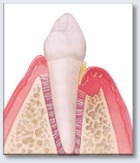
Before Surgery
A deep pocket allows plaque and tartar to collect far below the gum line. Inflammation and infection have destroyed some supporting bone.
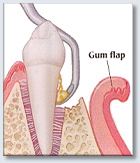
Opening the Gum
The gum is first lifted and rolled back, creating a “gum flap.” Tartar is then removed from the root. The surgeon also removes diseased gum tissue
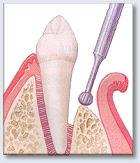
Shaping the Bone
If needed, the bone is smoothed and reshaped. This reduces pits and rough areas where bacteria grow.
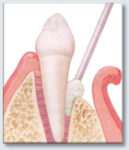
Helping Tissue Heal
A substance may be applied to the root to help the ligaments and gum reattach. Instruments may be used to cauterize (seal off) the area and reduce bleeding.
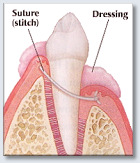
Closing Up
The gum flap is sewn shut in a position that reduces pocket depth. A dressing may be used to protect the area. This dressing is a bit like clay or putty. If used, it remains in place until removed by your dentist at a follow-up visit
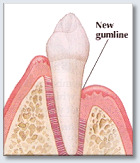
After the Gum Heals
Once the gum is healed, the stitches dissolve or are removed. Your dentist also removes the dressing. The pocket is shallower. With a lower gum line, it is likely that more of the tooth will be visible.
Regenerative Procedures
Certain procedures can be used to stimulate growth of new bone. This increases the height of the bone around the tooth, giving it more support. Getting back even half the lost bone height extends the life of the tooth.
Bone Replacement Graft
A graft helps your body replace lost bone. The graft consists of your own bone, synthetic material, or bone from a tissue bank. A gel containing growth factors may also be used to stimulate tissues to grow.
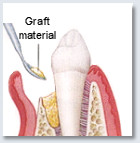
Placing the Graft
First, a gum flap is created. Growth factors may then be applied to the root. Graft material is packed into the area where bone was lost.
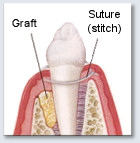
Closing Up
The gum is closed and sewn together. The growth factors stimulate tissue to grow. The graft provides a platform for new bone to grow.
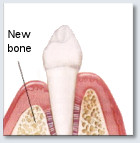 After the Area Heals
After the Area Heals
Stitches dissolve or are removed. Though the gum has healed, it takes a year or more for new bone growth to fill the space.
Guided Tissue Regeneration (GTR)
A special membrane is placed between gum and bone. This prevents gum tissue, which grows quickly, from filling the space where bone was lost. That way, new bone has time to grow where it’s needed.
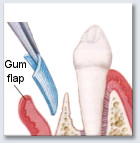 Surgery on Gum and Bone
Surgery on Gum and Bone
The gum is opened. Then a membrane is placed over the damaged bone
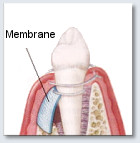 Separating Tissues
Separating Tissues
Once in place between bone and gum, the membrane allows space for bone to heal.
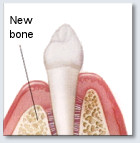 After Healing
After Healing
The stitches and membrane dissolve or are removed. In about a year, bone forms to support the tooth.
Gingival Grafting Surgery
When you look in the mirror, does the gum line look uneven? Or do you see too little gum? These are common effects of periodontal disease. Surgery on the gums can lower or even out the gum line. And if more of the tooth needs to be exposed, surgery can fix that too.
Soft Tissue Graft
When the gum isn’t supported by bone, the gum can start to pull away. A graft can be used to fill in an area where the gum has receded. The graft tissue may be taken from the roof of the mouth or from a tissue bank.
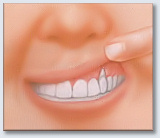 Before Surgery
Before Surgery
A gum line that has receded can expose the root. This can lead to tooth sensitivity and cavities in the root. The uneven gum line may also be visible when you smile.
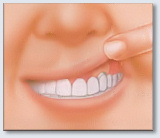 After Surgery
After Surgery
Graft tissue covers part or all of the exposed root. This protects the root and prevents the gum from receding further. It can also improve your appearance
Crown Lengthening – Surgery to include more of the crown includes:
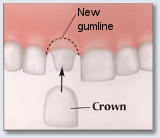 Functional Lengthening – In some cases, a restoration (artificial crown) is needed. Gum and bone are removed to expose enough tooth to anchor the new crown. This also helps prevent future damage to gum and bone near the restoration.
Functional Lengthening – In some cases, a restoration (artificial crown) is needed. Gum and bone are removed to expose enough tooth to anchor the new crown. This also helps prevent future damage to gum and bone near the restoration.
Functional Crown Lengthening – Gum and bone are removed. The remaining portion of the tooth can now support a replacement crown.
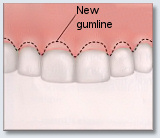 Cosmetic Lengthening – This is done to remove an overgrowth of gum tissue that causes a “gummy” smile. It can improve appearance and may make teeth easier to keep clean.
Cosmetic Lengthening – This is done to remove an overgrowth of gum tissue that causes a “gummy” smile. It can improve appearance and may make teeth easier to keep clean.
Cosmetic Crown Lengthening – Removing gum creates a more attractive smile.
LANAP Laser Surgery
New Technology For Treating Periodontal Disease
Laser Assisted New Attachment Procedure (LANAP) is a laser based technique for treating periodontal disease without using a scalpel and sutures. This alternative is more comfortable for the patient than conventional gum surgery which can be very painful.
How Does It Work?
Tartar, associated with inflamed and bleeding gums, is removed from the root surface of the tooth using an ultrasonic scaler and small instruments.
Next, a small amount of light energy from a laser is directed through a tiny fiber, which is gently placed between the gum and tooth. This light energy removes a tiny amount of diseased tissue and aids in reducing the bacteria associated with periodontal disease. After the area is thoroughly cleaned the body can heal the area naturally.
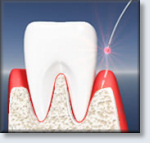
Laser accesses the pocket.
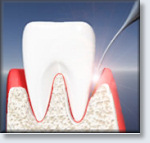
Laser removes diseased tissue, leaving important connective fibers in place.
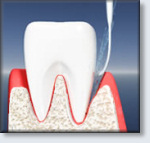
Ultrasonic scaler removes root surface deposits.
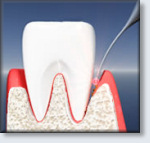
Laser finishes debriding the pocket.
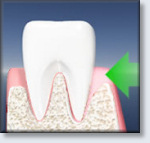
The tissue is compressed against the root surface and a stable fibrin clot forms.
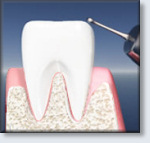
The bite is adjusted where needed to balance the forces on the teeth.
Some of these benefits are:
- No healthy tissue is removed, enhancing the chance for the gum tissue to reattach to the tooth surface without further exposure of the root
- Less pain & less bleeding
- Faster healing with little or no “down time”
- Laser Therapy stimulates bone regeneration
FDA approved PerioLase® Laser
Port Charlotte Periodontist Dr. Carol Stevens uses the FDA approved PerioLase® Laser for treating periodontal disease. If you suffer from tender, red, swollen, or bleeding gums, call Dr. Carol Stevens for an appointment to evaluate your condition.
